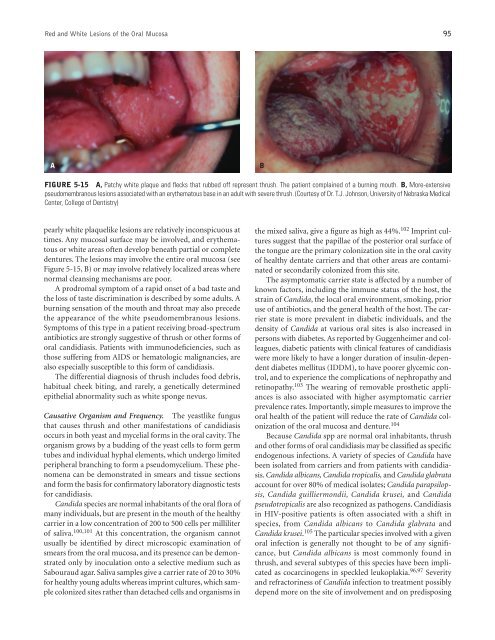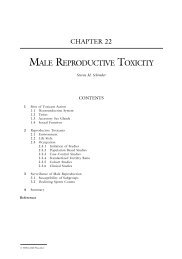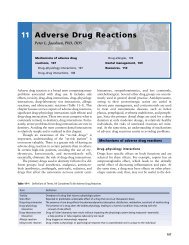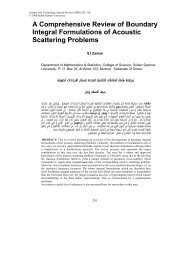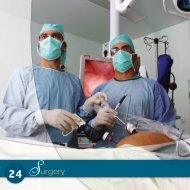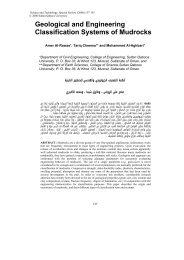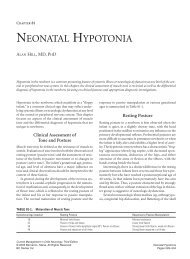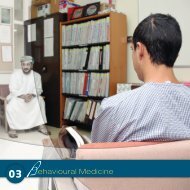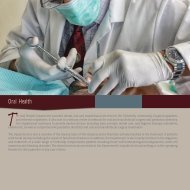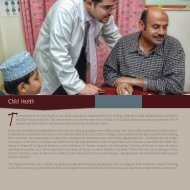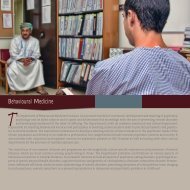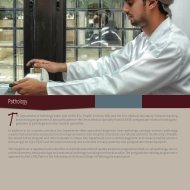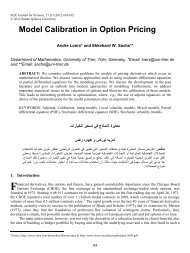Ch05: Red and White Lesions of the Oral Mucosa
Ch05: Red and White Lesions of the Oral Mucosa
Ch05: Red and White Lesions of the Oral Mucosa
You also want an ePaper? Increase the reach of your titles
YUMPU automatically turns print PDFs into web optimized ePapers that Google loves.
<strong>Red</strong> <strong>and</strong> <strong>White</strong> <strong>Lesions</strong> <strong>of</strong> <strong>the</strong> <strong>Oral</strong> <strong>Mucosa</strong> 95<br />
A B<br />
FIGURE 5-15 A, Patchy white plaque <strong>and</strong> flecks that rubbed <strong>of</strong>f represent thrush. The patient complained <strong>of</strong> a burning mouth. B, More-extensive<br />
pseudomembranous lesions associated with an ery<strong>the</strong>matous base in an adult with severe thrush. (Courtesy <strong>of</strong> Dr. T.J. Johnson, University <strong>of</strong> Nebraska Medical<br />
Center, College <strong>of</strong> Dentistry)<br />
pearly white plaquelike lesions are relatively inconspicuous at<br />
times. Any mucosal surface may be involved, <strong>and</strong> ery<strong>the</strong>matous<br />
or white areas <strong>of</strong>ten develop beneath partial or complete<br />
dentures. The lesions may involve <strong>the</strong> entire oral mucosa (see<br />
Figure 5-15, B) or may involve relatively localized areas where<br />
normal cleansing mechanisms are poor.<br />
A prodromal symptom <strong>of</strong> a rapid onset <strong>of</strong> a bad taste <strong>and</strong><br />
<strong>the</strong> loss <strong>of</strong> taste discrimination is described by some adults. A<br />
burning sensation <strong>of</strong> <strong>the</strong> mouth <strong>and</strong> throat may also precede<br />
<strong>the</strong> appearance <strong>of</strong> <strong>the</strong> white pseudomembranous lesions.<br />
Symptoms <strong>of</strong> this type in a patient receiving broad-spectrum<br />
antibiotics are strongly suggestive <strong>of</strong> thrush or o<strong>the</strong>r forms <strong>of</strong><br />
oral c<strong>and</strong>idiasis. Patients with immunodeficiencies, such as<br />
those suffering from AIDS or hematologic malignancies, are<br />
also especially susceptible to this form <strong>of</strong> c<strong>and</strong>idiasis.<br />
The differential diagnosis <strong>of</strong> thrush includes food debris,<br />
habitual cheek biting, <strong>and</strong> rarely, a genetically determined<br />
epi<strong>the</strong>lial abnormality such as white sponge nevus.<br />
Causative Organism <strong>and</strong> Frequency. The yeastlike fungus<br />
that causes thrush <strong>and</strong> o<strong>the</strong>r manifestations <strong>of</strong> c<strong>and</strong>idiasis<br />
occurs in both yeast <strong>and</strong> mycelial forms in <strong>the</strong> oral cavity. The<br />
organism grows by a budding <strong>of</strong> <strong>the</strong> yeast cells to form germ<br />
tubes <strong>and</strong> individual hyphal elements, which undergo limited<br />
peripheral branching to form a pseudomycelium. These phenomena<br />
can be demonstrated in smears <strong>and</strong> tissue sections<br />
<strong>and</strong> form <strong>the</strong> basis for confirmatory laboratory diagnostic tests<br />
for c<strong>and</strong>idiasis.<br />
C<strong>and</strong>ida species are normal inhabitants <strong>of</strong> <strong>the</strong> oral flora <strong>of</strong><br />
many individuals, but are present in <strong>the</strong> mouth <strong>of</strong> <strong>the</strong> healthy<br />
carrier in a low concentration <strong>of</strong> 200 to 500 cells per milliliter<br />
<strong>of</strong> saliva. 100,101 At this concentration, <strong>the</strong> organism cannot<br />
usually be identified by direct microscopic examination <strong>of</strong><br />
smears from <strong>the</strong> oral mucosa, <strong>and</strong> its presence can be demonstrated<br />
only by inoculation onto a selective medium such as<br />
Sabouraud agar. Saliva samples give a carrier rate <strong>of</strong> 20 to 30%<br />
for healthy young adults whereas imprint cultures, which sample<br />
colonized sites ra<strong>the</strong>r than detached cells <strong>and</strong> organisms in<br />
<strong>the</strong> mixed saliva, give a figure as high as 44%. 102 Imprint cultures<br />
suggest that <strong>the</strong> papillae <strong>of</strong> <strong>the</strong> posterior oral surface <strong>of</strong><br />
<strong>the</strong> tongue are <strong>the</strong> primary colonization site in <strong>the</strong> oral cavity<br />
<strong>of</strong> healthy dentate carriers <strong>and</strong> that o<strong>the</strong>r areas are contaminated<br />
or secondarily colonized from this site.<br />
The asymptomatic carrier state is affected by a number <strong>of</strong><br />
known factors, including <strong>the</strong> immune status <strong>of</strong> <strong>the</strong> host, <strong>the</strong><br />
strain <strong>of</strong> C<strong>and</strong>ida, <strong>the</strong> local oral environment, smoking, prior<br />
use <strong>of</strong> antibiotics, <strong>and</strong> <strong>the</strong> general health <strong>of</strong> <strong>the</strong> host. The carrier<br />
state is more prevalent in diabetic individuals, <strong>and</strong> <strong>the</strong><br />
density <strong>of</strong> C<strong>and</strong>ida at various oral sites is also increased in<br />
persons with diabetes. As reported by Guggenheimer <strong>and</strong> colleagues,<br />
diabetic patients with clinical features <strong>of</strong> c<strong>and</strong>idiasis<br />
were more likely to have a longer duration <strong>of</strong> insulin-dependent<br />
diabetes mellitus (IDDM), to have poorer glycemic control,<br />
<strong>and</strong> to experience <strong>the</strong> complications <strong>of</strong> nephropathy <strong>and</strong><br />
retinopathy. 103 The wearing <strong>of</strong> removable pros<strong>the</strong>tic appliances<br />
is also associated with higher asymptomatic carrier<br />
prevalence rates. Importantly, simple measures to improve <strong>the</strong><br />
oral health <strong>of</strong> <strong>the</strong> patient will reduce <strong>the</strong> rate <strong>of</strong> C<strong>and</strong>ida colonization<br />
<strong>of</strong> <strong>the</strong> oral mucosa <strong>and</strong> denture. 104<br />
Because C<strong>and</strong>ida spp are normal oral inhabitants, thrush<br />
<strong>and</strong> o<strong>the</strong>r forms <strong>of</strong> oral c<strong>and</strong>idiasis may be classified as specific<br />
endogenous infections. A variety <strong>of</strong> species <strong>of</strong> C<strong>and</strong>ida have<br />
been isolated from carriers <strong>and</strong> from patients with c<strong>and</strong>idiasis.<br />
C<strong>and</strong>ida albicans, C<strong>and</strong>ida tropicalis, <strong>and</strong> C<strong>and</strong>ida glabrata<br />
account for over 80% <strong>of</strong> medical isolates; C<strong>and</strong>ida parapsilopsis,<br />
C<strong>and</strong>ida guilliermondii, C<strong>and</strong>ida krusei, <strong>and</strong> C<strong>and</strong>ida<br />
pseudotropicalis are also recognized as pathogens. C<strong>and</strong>idiasis<br />
in HIV-positive patients is <strong>of</strong>ten associated with a shift in<br />
species, from C<strong>and</strong>ida albicans to C<strong>and</strong>ida glabrata <strong>and</strong><br />
C<strong>and</strong>ida krusei. 105 The particular species involved with a given<br />
oral infection is generally not thought to be <strong>of</strong> any significance,<br />
but C<strong>and</strong>ida albicans is most commonly found in<br />
thrush, <strong>and</strong> several subtypes <strong>of</strong> this species have been implicated<br />
as cocarcinogens in speckled leukoplakia. 96,97 Severity<br />
<strong>and</strong> refractoriness <strong>of</strong> C<strong>and</strong>ida infection to treatment possibly<br />
depend more on <strong>the</strong> site <strong>of</strong> involvement <strong>and</strong> on predisposing


